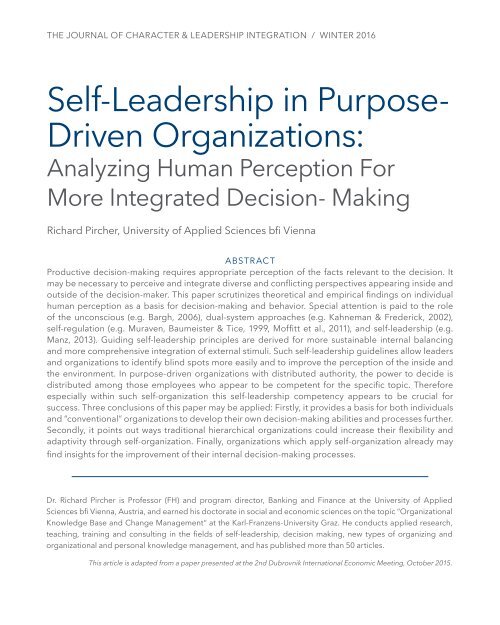PROFESSION OF ARMS
Yi5mwL
Yi5mwL
Create successful ePaper yourself
Turn your PDF publications into a flip-book with our unique Google optimized e-Paper software.
THE JOURNAL <strong>OF</strong> CHARACTER & LEADERSHIP INTEGRATION / WINTER 2016<br />
Self-Leadership in Purpose-<br />
Driven Organizations:<br />
Analyzing Human Perception For<br />
More Integrated Decision- Making<br />
Richard Pircher, University of Applied Sciences bfi Vienna<br />
ABSTRACT<br />
Productive decision-making requires appropriate perception of the facts relevant to the decision. It<br />
may be necessary to perceive and integrate diverse and conflicting perspectives appearing inside and<br />
outside of the decision-maker. This paper scrutinizes theoretical and empirical findings on individual<br />
human perception as a basis for decision-making and behavior. Special attention is paid to the role<br />
of the unconscious (e.g. Bargh, 2006), dual-system approaches (e.g. Kahneman & Frederick, 2002),<br />
self-regulation (e.g. Muraven, Baumeister & Tice, 1999, Moffitt et al., 2011), and self-leadership (e.g.<br />
Manz, 2013). Guiding self-leadership principles are derived for more sustainable internal balancing<br />
and more comprehensive integration of external stimuli. Such self-leadership guidelines allow leaders<br />
and organizations to identify blind spots more easily and to improve the perception of the inside and<br />
the environment. In purpose-driven organizations with distributed authority, the power to decide is<br />
distributed among those employees who appear to be competent for the specific topic. Therefore<br />
especially within such self-organization this self-leadership competency appears to be crucial for<br />
success. Three conclusions of this paper may be applied: Firstly, it provides a basis for both individuals<br />
and “conventional” organizations to develop their own decision-making abilities and processes further.<br />
Secondly, it points out ways traditional hierarchical organizations could increase their flexibility and<br />
adaptivity through self-organization. Finally, organizations which apply self-organization already may<br />
find insights for the improvement of their internal decision-making processes.<br />
Dr. Richard Pircher is Professor (FH) and program director, Banking and Finance at the University of Applied<br />
Sciences bfi Vienna, Austria, and earned his doctorate in social and economic sciences on the topic “Organizational<br />
Knowledge Base and Change Management“ at the Karl-Franzens-University Graz. He conducts applied research,<br />
teaching, training and consulting in the fields of self-leadership, decision making, new types of organizing and<br />
organizational and personal knowledge management, and has published more than 50 articles.<br />
This article is adapted from a paper presented at the 2nd Dubrovnik International Economic Meeting, October 2015.


